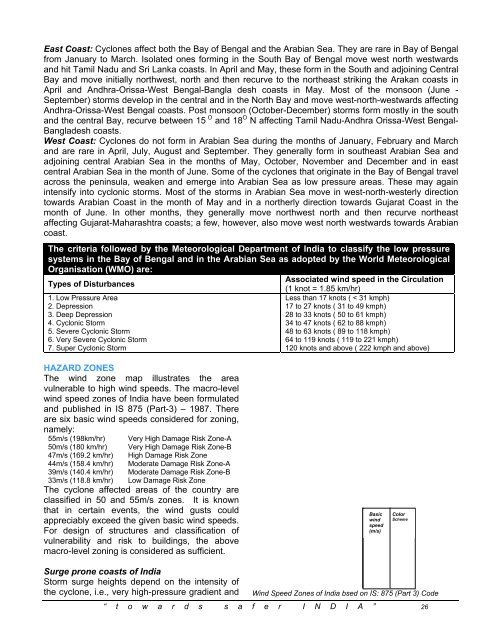Hazards, Disasters And Your Community - United Nations ...
Hazards, Disasters And Your Community - United Nations ...
Hazards, Disasters And Your Community - United Nations ...
Create successful ePaper yourself
Turn your PDF publications into a flip-book with our unique Google optimized e-Paper software.
East Coast: Cyclones affect both the Bay of Bengal and the Arabian Sea. They are rare in Bay of Bengal<br />
from January to March. Isolated ones forming in the South Bay of Bengal move west north westwards<br />
and hit Tamil Nadu and Sri Lanka coasts. In April and May, these form in the South and adjoining Central<br />
Bay and move initially northwest, north and then recurve to the northeast striking the Arakan coasts in<br />
April and <strong>And</strong>hra-Orissa-West Bengal-Bangla desh coasts in May. Most of the monsoon (June -<br />
September) storms develop in the central and in the North Bay and move west-north-westwards affecting<br />
<strong>And</strong>hra-Orissa-West Bengal coasts. Post monsoon (October-December) storms form mostly in the south<br />
and the central Bay, recurve between 15 O and 18 O N affecting Tamil Nadu-<strong>And</strong>hra Orissa-West Bengal-<br />
Bangladesh coasts.<br />
West Coast: Cyclones do not form in Arabian Sea during the months of January, February and March<br />
and are rare in April, July, August and September. They generally form in southeast Arabian Sea and<br />
adjoining central Arabian Sea in the months of May, October, November and December and in east<br />
central Arabian Sea in the month of June. Some of the cyclones that originate in the Bay of Bengal travel<br />
across the peninsula, weaken and emerge into Arabian Sea as low pressure areas. These may again<br />
intensify into cyclonic storms. Most of the storms in Arabian Sea move in west-north-westerly direction<br />
towards Arabian Coast in the month of May and in a northerly direction towards Gujarat Coast in the<br />
month of June. In other months, they generally move northwest north and then recurve northeast<br />
affecting Gujarat-Maharashtra coasts; a few, however, also move west north westwards towards Arabian<br />
coast.<br />
The criteria followed by the Meteorological Department of India to classify the low pressure<br />
systems in the Bay of Bengal and in the Arabian Sea as adopted by the World Meteorological<br />
Organisation (WMO) are:<br />
Associated wind speed in the Circulation<br />
Types of Disturbances<br />
1. Low Pressure Area<br />
2. Depression<br />
3. Deep Depression<br />
4. Cyclonic Storm<br />
5. Severe Cyclonic Storm<br />
6. Very Severe Cyclonic Storm<br />
7. Super Cyclonic Storm<br />
(1 knot = 1.85 km/hr)<br />
Less than 17 knots ( < 31 kmph)<br />
17 to 27 knots ( 31 to 49 kmph)<br />
28 to 33 knots ( 50 to 61 kmph)<br />
34 to 47 knots ( 62 to 88 kmph)<br />
48 to 63 knots ( 89 to 118 kmph)<br />
64 to 119 knots ( 119 to 221 kmph)<br />
120 knots and above ( 222 kmph and above)<br />
HAZARD ZONES<br />
The wind zone map illustrates the area<br />
vulnerable to high wind speeds. The macro-level<br />
wind speed zones of India have been formulated<br />
and published in IS 875 (Part-3) – 1987. There<br />
are six basic wind speeds considered for zoning,<br />
namely:<br />
55m/s (198km/hr) Very High Damage Risk Zone-A<br />
50m/s (180 km/hr) Very High Damage Risk Zone-B<br />
47m/s (169.2 km/hr) High Damage Risk Zone<br />
44m/s (158.4 km/hr) Moderate Damage Risk Zone-A<br />
39m/s (140.4 km/hr) Moderate Damage Risk Zone-B<br />
33m/s (118.8 km/hr) Low Damage Risk Zone<br />
The cyclone affected areas of the country are<br />
classified in 50 and 55m/s zones. It is known<br />
that in certain events, the wind gusts could<br />
appreciably exceed the given basic wind speeds.<br />
For design of structures and classification of<br />
vulnerability and risk to buildings, the above<br />
macro-level zoning is considered as sufficient.<br />
Basic<br />
wind<br />
speed<br />
(m/s)<br />
Color<br />
Scheme<br />
Surge prone coasts of India<br />
Storm surge heights depend on the intensity of<br />
the cyclone, i.e., very high-pressure gradient and<br />
Wind Speed Zones of India bsed on IS: 875 (Part 3) Code<br />
“ t o w a r d s s a f e r I N D I A ” 26

















